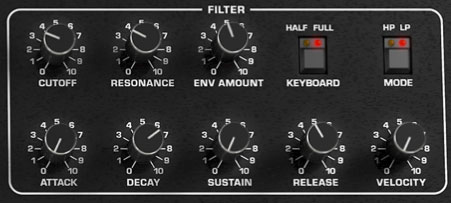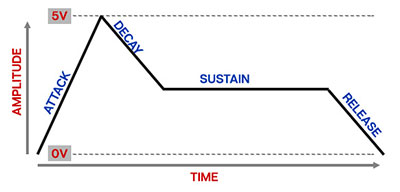
The original instrument made use of CEM3320 filter chips. These were very common in the heyday of polyphonic analog and hybrid synths. The original instrument contained twenty of these, running in a 24 dB/oct lowpass configuration and greatly contributed to the rich Prophet sound.
How Lowpass and Highpass Filters work
A lowpass filter allows frequencies below the cutoff frequency setting to pass through, but blocks frequencies above the cutoff frequency. If the cutoff frequency is all the way up, that means all audio signal pass; as the knob setting is lower, high frequencies are filtered.
Conversely, a highpass filter operates in exactly the opposite fashion - frequencies above the cutoff frequency setting pass through, and frequencies below the cutoff frequency are blocked.
Controls

Cutoff- Sets the frequency where frequency attenuation begins, i.e. which frequencies are allowed to pass.
Resonance- Resonance emphasizes sound energy at and around the current cutoff frequency by adding feedback from the filter's output back to its input. At lower settings, this can be used to create mild resonances such as those heard in acoustic instruments. At extreme settings, it can be used as a sine wave generator, but be careful as high resonance settings can result in loud, screamy, dog-spooking (and speaker blowing) occurrences.
Envelope Amount- The Envelope control applies modulation from the Filter Envelope below to the cutoff frequency. This allows familiar auto filter sweeps. When raising the Envelope control, you'll generally want to lower the Cutoff control, as these control signals sum together (right now).
Keyboard- This causes the cutoff frequency to increase as ascending notes are played on a keyboard. The idea behind this is that the Keyboard control applies a rising CV to the cutoff frequency in order to maintain the brightness of notes as higher pitches are played (because actual note frequencies rise as higher pitches are played).
Half- The original only included an on/off Keyboard switch - this routed the entire keyboard voltage to the filter cutoff, meaning that the filter frequency tracked the keyboard exactly. We've added a Half setting, which causes the cutoff to gain brightness, well, half as much as higher keys are played.
Full- Filter cutoff frequency tracks the keyboard at rate of 1V/octave, just like the original instrument with the Keyboard button enabled.
Mode- Though none of the original Prophet instruments included a multimode filter, along the development path, we discovered that adding a highpass filter mode really expanded P-10's tonal possibilities, particularly in stacked, dual-layer patches, so we added it.
LP- 24/dB per octave lowpass filter, voiced to emulate the original Curtis 3320 filter chips.
HP- 24/dB per octave highpass filter - also voice like the Curtis chips, which could be configured to run in highpass mode, but this was never implemented in the original instruments.
Filter Envelope
The Filter Envelope is a dedicated envelope generator for control of cutoff frequency, via the Envelope Amount knob.
How An ADSR Envelope Generator Works

When P-10 sees a gate voltage from a note, the envelope generator outputs a dynamically changing voltage, according to the settings of its four stages. The attack stage defines how long it takes for the output voltage to rise from zero to full scale. Once the attack stage reaches its max amount, it moves to the decay phase, which defines how long it takes to fall from full scale to the setting of the sustain phase. Unlike the attack, decay, and release phases, which define times, sustain simply sets the held voltage level following the attack and decay phases - this equates to the envelope output level while holding down a key. Finally, the release slider defines the the length of time it takes for the voltage to fall back to zero when the gate input voltage is removed, i.e. when the key is released.

Controls
Attack- Defines the length of time for cutoff frequency voltage to rise from zero to full scale when a key is played.
Decay- Defines the length of time for cutoff frequency voltage to fall from the attack stage peak to sustain stage setting.
Sustain- Sets the cutoff frequency voltage level following attack and decay phases while a note is held.
Release- Defines the length of time for cutoff frequency voltage to fall from sustain level to zero when a key is released.
Velocity- Defines how much the envelope affects the filter cutoff frequency via keyboard velocity. When set to zero, keyboard velocity has no effect on cutoff frequency; all the way up results in maximum control range.